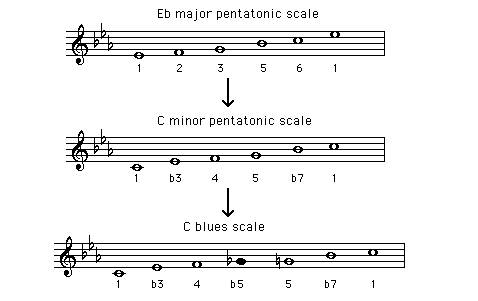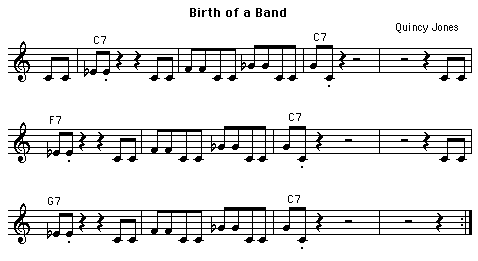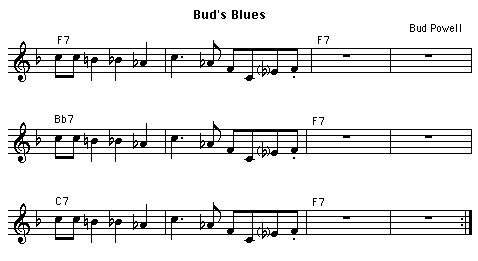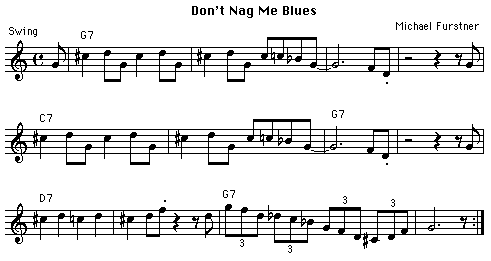(Down - Top - Links)
BL 7.1 - The Blues Scale
The Blues scale is a 6-note scale.
It is derived from the Minor pentatonic scale by adding just one note, the b5 (or #4).
The progressive transformation from
Major Pentatonic scale ---> Minor pentatonic scale ---> Blues scale
for the C Blues scale goes like this :
Audio 7.1

The b3 , b5 and b7 are called the blue notes.
They are the notes that provide the typical blues sound.
Like the minor pentatonic scale, only one single Blues scale is used for improvisation over the entire blues chorus. The b3 in the blues scale (Eb above) clashes with the major 3rd (E) of the I chord, and the b7 in the blues scale (Bb above) clashes with the major 3rd (B) of the V chord, while the added b5 (Gb above) destroys the clean accoustic tonality of its "parent" minor pentatonic scale.
For the G Blues scale the transformation from major pentatonic to blues scale is :
Audio 7.2

The Major pentatonic scale and Minor pentatonic scale are very pure and natural sounding scales. This is because the notes of these scales are acoustically closely related.
The addition of the b5 note (who's acoustics are not related to the other scale tones) spoils this purity somewhat and gives the Blues scale therefore an unnatural flavour.
This is an important thing to remember when using this scale for improvisation.
The Blues scale aims to produce a special flavour that suits the Blues.
But it is a bit like sugar. Put too much of it in your cup of tea and it spoils the drink.
|
To sum up : the Blues scale is an easy and great scale for improvisation over the blues, but use it in moderation.
Too much of it and your improvisation becomes very repetitive and you start to sound like all those musicians who simply have no idea what else to play.
(Down - Up - Top - Links)
BL 7.3 - Birth of a Band
'Birth of a Band' by Quincy Jones is a famous tune by the Quincy Jones Big Band.
It features a very simple but powerful Blues riff, entirely composed from the C Blues scale.
Melody

C-instruments : use the C Blues scale for improvisation : C Eb F Gb G Bb C
Bb-instruments : use the D Blues scale for improvisation : D F G Ab A C D
Eb-instruments : use the A Blues scale for improvisation : A C D Eb E G A
Play-a-Long tracks for the Blues in C (all instrument use the C blues scale).
- C- instruments use bblc.mid (or any other track in C)
- Bb- instruments use bblbb.mid (or any other track in Bb)
- Eb- instruments use bbleb.mid (or any other track in Eb)
(Down - Up - Top - Links)
BL 7.4 - Bud's Blues
This blues riff by Bud Powell is also entirely composed from the Blues scale.
(The Eb on beat 4 of the second bar is usually played as an E. This makes it a 7 rather than a b7 in the scale, and outside the Blues scale.)
Melody

C-instruments : use the F Blues scale for improvisation : F Ab Bb B C Eb F
Bb-instruments : use the G Blues scale for improvisation : G Bb C Db D F G
Eb-instruments : use the D Blues scale for improvisation : D F G Ab A C D
Play-a-Long tracks for the Blues in F (all instrument use the F blues scale).
- C- instruments use bblf.mid (or any other track in F)
- Bb- instruments use bbleb.mid (or any other track in Eb)
- Eb- instruments use bblab.mid (or any other track in Ab)
(Down - Up - Top - Links)
BL 7.5 - Don't Nag Me Blues
'Don't Nag Me Blues' is another blues entirely composed from the Blues scale.
|
This song is a firm musical warning to all naggers (male and female) that too much nagging will ultimately drive the suffering partner away, at the speed of triplet quavers (in bar 11).
|
Melody

C-instruments : use the G Blues scale for improvisation : G Bb C Db D F G
Bb-instruments : use the A Blues scale for improvisation : A C D Eb E G A
Eb-instruments : use the E Blues scale for improvisation : E G A Bb B D E
Play-a-Long tracks for the Blues in G (all instrument use the G blues scale).
- C- instruments use bblg.mid (or any other track in G)
- Bb- instruments use bblf.mid (or any other track in F)
- Eb- instruments use bblbb.mid (or any other track in Bb)